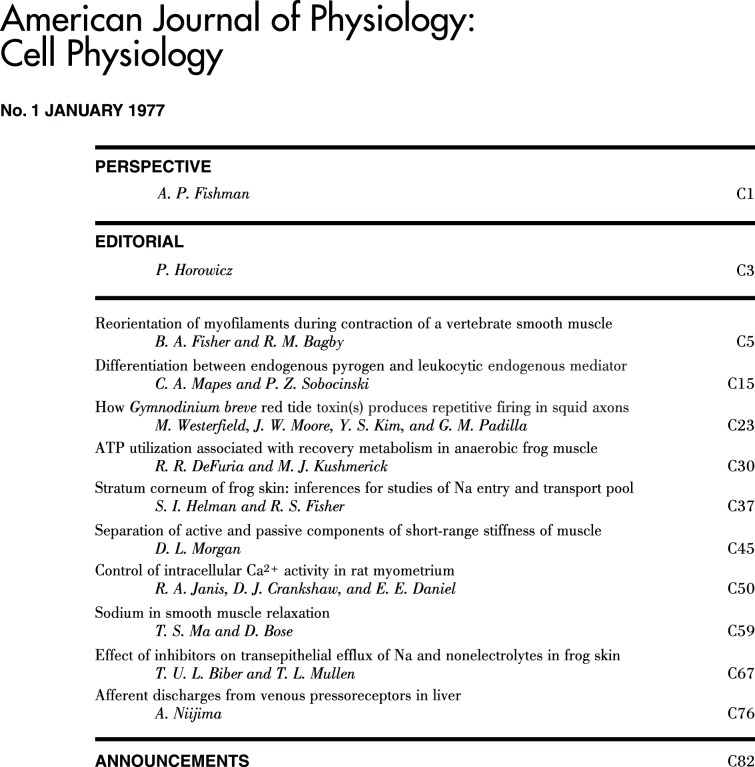ajp-cell physiology began in January 1977 upon the conversion of the American Journal of Physiology into a suite of Journals that embraced different areas of Physiology, either tissue-specific, or, as for AJP-Cell Physiology, covering the realm of cells and molecules as the fundamental levels of organization of physiological processes.
The first issue of AJP-Cell Physiology included ten research articles that included a broad range of cell and tissue systems and research areas, several of which continue to this day and will be recognizable to today’s readers and authors (Fig. 1, the first contents list). Thus, 2017 marked the fortieth anniversary of the inception of AJP-Cell Physiology. It was decided at our senior Editors’ meeting during Experimental Biology 2016 to mark this event by beginning an occasional series of authoritative Reviews that would address the progress of central research areas in cell and molecular physiology and pathophysiology during the last forty years. It was also felt that these Reviews, by providing context on the development of major fields along with open questions and remaining controversies, would have an additional value for the next generation of researchers.
Fig. 1.
The Index page of the first issue of AJP-Cell Physiology.
We are delighted to begin this series with a landmark Review contributed by Professor Mordecai P. Blaustein, of the University of Maryland at Baltimore. Professor Blaustein, a discoverer of the Na+/Ca2+ exchanger, provides a personal perspective on the development of laboratory research into the endogenous ouabain/Na+ pump endocrine system and its role in Na+-dependent hypertension (1). This article is especially appropriate to mark AJP-Cell Physiology’s anniversary year, because Dr. Blaustein’s hypothesis on the relationships between Na+ and Ca2+ ions, their pumps, blood pressure regulation and hypertension was published to great attention in AJP-Cell Physiology in May 1977 (2).
In the current Review, Dr. Blaustein provides a personal account of discoveries related to how cardiotonic steroids work in treating heart failure, the relationship between endogenous cardiotonic steroids and blood pressure, and the identification of this circulating, endogenous organic compound, known as ouabain. The story began with an experimental finding in arthropods and led to the revelation of pathogenic mechanisms and development of therapeutic interventions for human cardiovascular disease. Dr. Blaustein also summarizes work with mouse models carrying mutations in pump subunits and endogenous ouabain signaling in the brain. The Review touches on other research fields, such as muscle fatigue, neurobehavior and inflammatory response. This fascinating read provides a concise summary of the status of this important field, and also offers numerous historical perspectives and views (biographical and others) that convey true love and excitement for science, even in face of all too familiar setbacks and rejections.
Dr. Blaustein’s historical overview of the Na+ pump and Na+/Ca2+ exchanger is very inspiring and reminds all scientists that we need to “look” backwards to “see” the future. Younger scientists can gain a wealth of knowledge from prior research to aid them to formulate their own research ideas. At the same time, as discussed in the Review, ongoing controversies remain. In the next forty years, new technologies, “big data” and quantitative models will undoubtedly provide a new integrative framework to understand the physiology and pathophysiology of blood pressure regulation and to fine-tune clinical treatments.
The publication of this Review marks the beginning of an occasional series of outstanding Landmark Reviews. We hope that readers of AJP-Cell Physiology will find these articles valuable and stimulating.
DISCLOSURES
No conflicts of interest, financial or otherwise, are declared by the authors.
AUTHOR CONTRIBUTIONS
E.D., K.L.H., J.X.-J.Y., and J.C.A. drafted manuscript; E.D., K.L.H., T.J.H., J.X.-J.Y., and J.C.A. edited and revised manuscript; E.D., K.L.H., T.J.H., J.S.I., S.L., J.X.-J.Y., and J.C.A. approved final version of manuscript.
REFERENCES
- 1.Blaustein MP. The pump, the exchanger, and the holy spirit: origins and 40-year evolution of ideas about the ouabain-Na+ pump endocrine system. Am J Physiol Cell Physiol 314: 3–26, 2018. doi: 10.1152/ajpcell.00196.2017. [DOI] [PMC free article] [PubMed] [Google Scholar]
- 2.Blaustein MP. Sodium ions, calcium ions, blood pressure regulation, and hypertension: a reassessment and a hypothesis. Am J Physiol Cell Physiol 232: C165–C173, 1977. [DOI] [PubMed] [Google Scholar]



